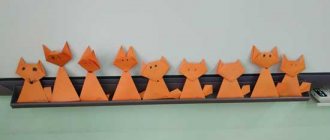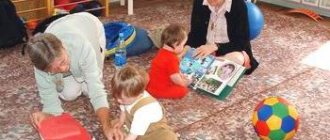Club work at preschool educational institutions
First, I would like to talk in general about what place circle work occupies in the activities of a kindergarten, why it is needed, what goals it pursues and how it is organized.
So, any planning of a group’s work for the year includes the inclusion in the plan of various clubs in which children will study in addition to the general main load of compulsory classes. This is the so-called variable part of the program.
The wide selection of clubs in kindergarten today will amaze even the most demanding parent. However, despite the variety of thematic areas, all circles are organized and function according to the same patterns.
A circle is the bringing together of children in a group for activities based on a common interest. When choosing a topic for a circle, the interests and needs of children, as well as the wishes of parents, are taken into account, which can be found out through conversations, consultations, surveys and parent-teacher meetings. And, as mentioned above, within the circle, children are taught material that goes beyond the standard of preschool education.
Functions of clubs in kindergarten:
- educational;
- socially adaptive;
- correctional and developmental;
- educational.
Clubs are organized in kindergarten with the following goals:
- to deepen and expand the knowledge acquired through basic education;
- to become familiar with knowledge that is not included in the state program (for gifted children);
- for the development of skills that develop self-knowledge, self-development, self-regulation, and interpersonal communication skills.
When carrying out circle work, the teacher must find the right emotional wave in order to interest children in the proposed activity. Communication should occur easily and naturally, bringing pleasure to both the teacher and the children.
At the same time, it is important to take into account such conditions as convenient organization of the workspace, activities for children based on their strengths and interests, and presentation of material in the form of a game.
Club work with children is carried out in the form of frontal group classes, excursions, walks, entertainment events and competitions.
As a rule, circles are organized in the following four areas:
- physical development;
- social - personal development;
- cognitive and speech development;
- artistic and aesthetic development.
Plan of an “Origami” circle in the middle group of a preschool educational institution.
Origami circle program plan
"Magic Paper"
Educator
Wilman L.G.
Saratov 2019
Explanatory note.
Preschool age is a bright, unique page in the life of every person. It is during this period that the child’s connection with the leading spheres of existence is established: the world of people, nature, the objective world. There is an introduction to culture, to universal human values. Curiosity develops and interest in creativity is formed.
Currently, issues of capacity development are attracting more and more attention. It has become obvious that the expanded (sometimes excessive) field of knowledge, abilities and skills that modern children possess does not bring the desired results when studying at school. Therefore, it is necessary to take care to form the child’s activity in understanding the world around him, solving cognitive problems, and prepare him for the conscious acquisition of knowledge.
Why origami? The expediency of introducing the course is justified by two circumstances: firstly, preschoolers are characterized by a desire to create, as well as a desire to obtain quick results; secondly, origami has a huge educational effect.
Origami has a great influence on the development of creative imagination and perception.
At the very beginning of work, the child has to focus on reading the folding diagram. Already this initial work is aimed at developing the highest form of perception - meaningful visual perception, which is associated with various operations of thinking.
Then the child meets the paper - tactile perception is activated. With his fingers he perceives the surface roughness, density, elasticity of the paper, pays attention to color, reaction to folding.
The finished figurine is not an exact copy of an animal, bird or flower, it is an image. But the child understands that in front of him is a cat, a fish, a butterfly. It turns out that you can create a whole world from an ordinary sheet of paper. Children often talk to their figure and invent different stories. They learn not only to add, but also to compose.
Origami is also a kind of psychotherapy that can distract from worries: by folding paper, the child involuntarily concentrates his attention on this process. In addition, origami helps stimulate the activity of both the left and right hemispheres of the brain, since it requires simultaneous control over hand movements.
Observations of children doing origami have shown that it is easier for them to work with plans and diagrams in classes on design and orientation in space, their eye is better developed, and in general their intellectual abilities increase.
This activity strengthens family relationships. Many mothers, fathers, and older children attend classes in the evenings, forming a creative club united by a common interest. In these classes, both adults and children can master more complex origami figures, share homework, exchange literature on origami, and organize joint exhibitions and celebrations.
Origami classes allow children to satisfy their cognitive interests, expand awareness in this educational field, enrich communication skills and acquire the ability to carry out joint activities in the process of mastering the program. They also contribute to the development of fine motor skills, which has an important impact on the development of children’s speech.
This type of art has a beneficial effect on the development of attention and the formation of memory: children remember terms, techniques and folding methods, and, as needed, reproduce the knowledge and skills stored in memory.
The purpose of the program is
comprehensive intellectual and aesthetic development of children in the process of mastering the elementary techniques of origami technique, as an artistic method of designing from paper.
Program objectives:
— Introduce children to basic geometric concepts and basic origami shapes.
— Develop the ability to follow oral instructions.
— Teach various techniques for working with paper.
— To form and consolidate children’s knowledge about geometric shapes: circle, square, triangle, angle, side, vertex, etc.
— Enrich the child’s vocabulary with special terms.
-Develop attention, memory, logical and spatial imagination.
— Develop fine motor skills of the hands and eye.
-Develop the artistic taste, creativity and imagination of children. — Cultivate interest in the art of origami.
— Form a work culture and improve work skills.
— Contribute to the creation of play situations, expand children’s communication abilities.
— Improve labor skills, create a work culture, teach accuracy, the ability to use materials carefully and economically, and keep the workplace in order.
Methods
used in the circle classes:
· conversation, story, fairy tale;
· looking at illustrations;
· showing a sample of the work sequence;
· viewing presentations.
Since group 2-4 “Watercolors” is of different ages (3-5 years), material with accessible content for children 3-4 years old is selected for classes, with subsequent complication for children 4-5 years old.
Expected results:
As a result of training in this program, children will: – learn various techniques for working with paper; – will know the basic geometric concepts and basic shapes of origami; – learn to follow oral instructions, create origami products – develop attention, memory, thinking, spatial imagination; fine motor skills of hands and eye;
– get acquainted with the art of origami;
Forms for summing up the implementation of an additional educational program
• Compiling an album of the best works. • Holding exhibitions of children's works.
Work is carried out outside of class in the afternoon.
Lesson duration is 20 minutes.
Category of students: 4-5 years.
Perspective and thematic planning of circle activities.
October
| № | SUBJECT | TARGET | MATERIAL |
| 1. | Introduction to the art of origami FLAG | Teach children to fold a square in half with a “kerchief”, combining opposite corners. Cultivate interest in the results of your work. | Two red squares 15*15cm, two strips 1cm wide, 20cm long made of cardboard, glue. |
| 2. | CUP | Strengthen the ability to fold a square diagonally. Learn to bend the sharp corners of the resulting triangle to opposite sides and insert it into the resulting gap. Cultivate interest in the process of paper folding. | Square 10*10 any color. |
| 3. | Book | Learn to bend a rectangle in half, matching the short sides. | Three A4 rectangles: two of them are white, the third is colored, glue. |
| 4. | Herringbone | Teach children to fold a square in half, matching opposite corners, and bend the resulting triangle. Learn to make a Christmas tree out of triangles, starting from the bottom with the largest part. Cultivate accuracy when working with glue. | Three green squares 15*15cm, 10*10cm, 5*5cm, glue. |
November
| № | SUBJECT | TARGET | MATERIAL |
| 1. | Kite | To increase children's interest in making crafts using the origami technique, to consolidate the skills of decorating a finished figurine, and to practice free choice of colors. | Paper squares (10*10) of different colors, strips of multi-colored paper, glue. |
| 2. | Frog | Introduce the making of simple crafts using the origami technique by folding a square diagonally (the basic shape is “triangle”) | Green square (10*10). Blanks for frog eyes, scissors, glue. |
| 3. | Bunny | Continue to teach children how to make crafts using the origami technique, to cultivate independence and accuracy. | Square (10*10), blanks for eyes and muzzle, glue |
| 4. | Butterfly | Learn to bend a square diagonally, fold the resulting triangle in half, bend the upper sharp corners in different directions. Develop the ability to aesthetically correctly decorate your crafts. | Paper squares (10*10), blanks for eyes, scissors, glue |
December
| № | SUBJECT | TARGET | MATERIAL |
| 1 | Snowflakes | Teach children to connect parts in pairs, tucking the corner of one inside the other part. Continue to teach carefully and work with glue. Improve the skills of fine and precise finger movements of both the right and left hands. Cultivate interest in origami classes. | 12 blue squares 5*5, a blue circle with a diameter of 3cm and a white circle with a diameter of 2cm. |
| 2 | Gnome | Continue to teach children to make paper figures from two parts, teach clearly, follow the teacher’s instructions | Squares (8*8, 6*6) of different colors, paper scraps, glue, scissors. |
| 3 | New Year decoration | Continue to learn how to make simple crafts from paper squares, using already known paper folding techniques, to develop constructive thinking, fantasy, and imagination. | Multi-colored squares of different sizes, paper scraps, glue, thread, scissors. |
| 4 | Snowman | Teach children to connect parts in pairs, tucking the corner of one inside the other part. Continue to teach carefully and work with glue. Improve the skills of fine and precise finger movements of both the right and left hands. Cultivate interest in origami classes. | White paper, glue, scissors |
January
| № | TARGET | MATERIAL | |
| 1. | Kolobok | Teach children at rectangle, bend all corners evenly. Continue to learn how to decorate a craft with details (mouth, nose, eyes). Cultivate joy from handmade gifts. | Yellow rectangle 20*10cm, orange and red squares 3*3cm, two orange circles, glue. |
| 2. | Bunny | Strengthen the ability to bend the square with a “book” and twice with a “scarf”, lower the opposite corners to the center of the square, getting a “candy”. Continue to teach children to listen carefully to the teacher's instructions. Develop independence and attention. | Gray squares 8*8cm and 10*10cm, blanks for eyes and muzzle, glue. |
| 3. | Wolf | Continue to teach how to bend the square with a “scarf”, bend one of the corners upward diagonally. Strengthen the ability to glue a head and draw eyes. Develop your eye. Cultivate perseverance. | Two gray squares 15*15cm, 10*10cm, glue, blanks for eyes and nose. |
| 4. | Fox | Teach children to listen to the teacher’s oral instructions. Introduce basic geometric concepts in practice. Cultivate accuracy in working with paper. | Orange (red) square 15*15cm, rectangle 15*7.5cm, blanks for eyes and muzzle, glue. |
February
| № | SUBJECT | TARGET | MATERIAL |
| 1. | Bear | Learn to bend the “kerchief” in half. Learn to understand that the parts of the head and body are made separately from squares of different sizes. Bring up and develop the ability to control hand and finger movements with the help of the brain. | Brown squares 15*15cm, 10*10cm, two squares 6*6cm, glue. |
| 2. | boat | Introduce children to making crafts using the origami technique from a rectangular sheet of paper, practice freely choosing colors, develop fine motor skills, and use ready-made crafts in games. | Rectangular sheets 20*15cm. |
| 3. | Stars | Strengthen the ability to fold the basic “kite” shape. Learn to alternate colors, connect parts, applying the short side of the workpiece to the inflection line of the previous one. Cultivate perseverance and responsibility. | 8 squares 10*10cm, 4 of them one color, 4 another, glue. |
| 4. | Hen | Learn to fold a square twice with a “kerchief”, continue to teach children to listen carefully to the teacher’s instructions, to cultivate independence and attention. | Red square 3*3cm, yellow (orange) square 15*15cm, glue, pencil or felt-tip pen. |
March
| № | subject | target | material |
| 1. | Chrysanthemum | Introduce children to a new way of making flowers using the origami technique, and strengthen the ability to use scissors. | 16-20 squares (4*4) white or purple, yellow paper, scissors, glue. |
| 2. | Gift for mom | To introduce the design of postcards using figures made using the origami technique, to cultivate accuracy and perseverance | Multi-colored cardboard, squares of yellow, blue, red paper (10*10), green paper for leaves and stems, scissors, glue. |
| 3. | Turntables | Teach children to make new crafts from a square, circle, triangle, learn to use cut line markings on a workpiece, practice free choice of color and shape of paper, encourage independence and creative initiative. | Squares (15*15) of different colors, equilateral triangles with a side of 20 cm, circles with a diameter of 20 cm with cut lines drawn, cardboard circles, scissors, glue, sticks. |
| 4. | Kitty | Reinforce folding and naming basic shapes with children. Learn to make a torso and head separately from squares. Learn to fold a triangle in half with a “kerchief”, raising the corners from the middle of the long side, but not reaching the top of the upper corner. Cultivate accuracy in work and attention. | Two squares 15*15cm of the same color, pencils or markers for designing the face, glue. |
April
| № | SUBJECT | TARGET | MATERIAL |
| 1. | Gifts for kids | Using the origami technique, teach how to make models of birds and boats, cultivate a desire to take care of younger children, and practice free choice of colors. | Multi-colored squares (10*10) |
| 2. | Fish | Learn to fold paper using different basic shapes, teaming up in pairs to create a marine composition. | Blue cardboard, multi-colored squares, scissors, glue, paper scraps. |
| 3. | Owl | Remind how the basic kite shape is folded. Learn to bend the upper triangle forward and return it to its original position, make cuts along the fold line, and fold the ends. Cultivate accuracy in working with paper and scissors. | Square 10*10, blanks for eyes, glue, sheathAnd tsy. |
| 4. | Hedgehog | Continue teaching children to fold a square in half using a “book” shape. Understand the terms: “upper corner”, “lower corner”. Develop children's eye. Cultivate a caring attitude towards paper. | A square of gray or brown color 10*10cm, pencil or felt-tip pen to draw eyes and needles on the fur coat. |
May
| № | SUBJECT | TARGET | MATERIAL |
| 1. | The Rooks Have Arrived | Continue to teach children how to make crafts from the basic “kite” shape, and improve their skills in working with paper and scissors. | Black squares (15*15), blanks for eyes, scissors, glue. |
| 2. | Rowan branch | Strengthen the ability to make crafts from the basic “arrow” shape, cultivate accuracy, teach clearly, follow the teacher’s instructions | Cardboard, squares (1.5*1.5) orange or red, (3*3) green for leaves, glue. |
| 3. | My favorite origami. | Reinforce the origami techniques and forms learned in class. Improve the skills of fine and precise finger movements of both the right and left hands. Cultivate interest in the results of your work. | Multi-colored squares 10*10, scissors, glue. |
| 4. | Final lesson. Diagnostics | Making an album of children's works for the period of study. Development of communication skills and the ability to coordinate one’s interests with the interests of other children. | Album, crafts using origami technique, glue. |
Literature
1.Sokolova S.V. Origami for preschoolers: Method. manual for preschool teachers. - St. Petersburg: Detstvo-press, 2001.
2.Sokolova S. Origami theater: paper toys. — M.: EKSMO-press; St. Petersburg: Valeri SPD, 2002.
3.
Degtyova V. Origami with children 3-7 years old: a methodological guide.
Publisher: Mozaika-Sintez
Year: 2012
4. Sergeantova T.B. Origami for the whole family
5. V.V. Vygonov origami for kids. Simple models. Publisher: Exam Year: 2019
Downloaded from www.znanio.ru
Circles in the middle group
What directions and topics should we take for the middle group? I will say right away that long-term planning, as a rule, provides for several areas of activity that a kindergarten can offer based on the availability of teaching staff and logistics.
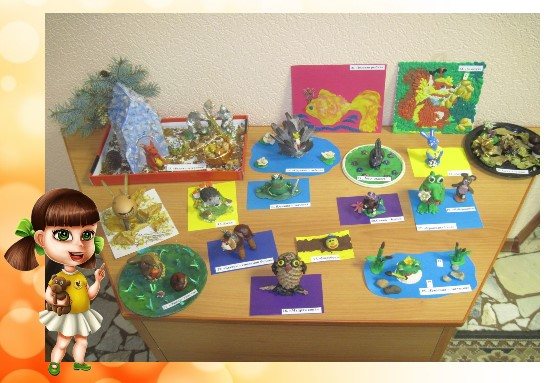
Since at this age all children love to make crafts, a circle called “Skillful Hands” would be an absolutely win-win option. Creative manual labor allows you to develop sensorimotor skills, improve coordination of movements, develops the child’s mental development and thinking, fosters independence, confidence and initiative. In such a circle, activities are carried out on working with paper and cardboard, including such areas as origami, with fabric and thread, natural and waste materials.
It is also quite possible to offer a circle on ecology and call it, for example, “Visiting Nature.” In preschool education, the ecological-biological direction allows you to understand nature, develop a humane attitude towards it and learn to consciously behave in the natural environment.
A child aged 4-5 years is a “why” who is interested in cause-and-effect relationships in living and inanimate nature. In order for children to get answers to all their questions, you can conduct excursions with observations, didactic games, quizzes and competitions, solve riddles, read literary works and have conversations with them.
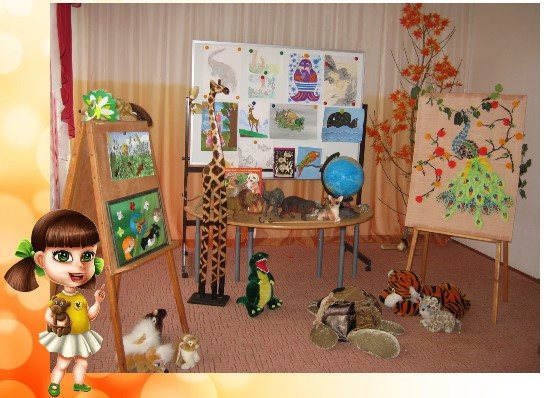
Also in this matter, practical methods of consolidating the learned material will be relevant: designing a herbarium, theatrical activities in the form of staging fairy tales and individual skits, making visual aids together with children.
If we consider the long-term plan for the work of a drawing circle, then we can offer many interesting techniques that are not provided for in the general education curriculum. The objectives of this circle are to get acquainted with non-traditional drawing techniques, use a wide variety of materials, get acquainted with different genres of fine art, develop in children a sense of form, color, proportion, as well as cultivate an aesthetic attitude towards the world around them.
Within the framework of this circle, you can teach children to draw with fingers, cotton swabs, make impressions with crumpled paper and imprints with leaves, master pointillism (drawing with dots), drawing with palms, cotton pads, toothpaste, blowing with a tube and much more, including such a direction as plasticineography.
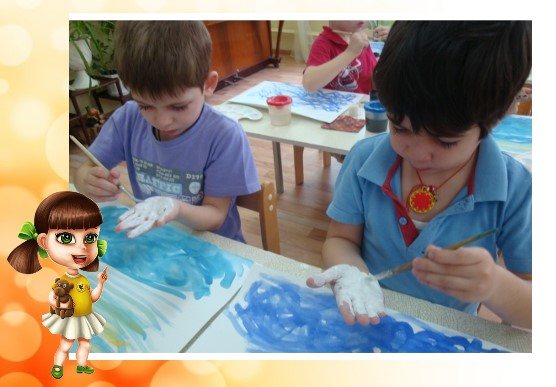
Middle group. Junior preschool age. Children 4 - 5 years old
The use of health-saving technologies in the circle work of a speech therapist teacher with children 3–4 years old (from work experience) The problem of preserving, strengthening and shaping the health of the younger generation is the main task of preschool education . The foundation of the well-being of the future generation should be based on protecting the health of the preschool child, on the formation and education of his culture of health...
Circle work on appliqué using non-traditional techniques in the middle group “Fur coat for a sheep”
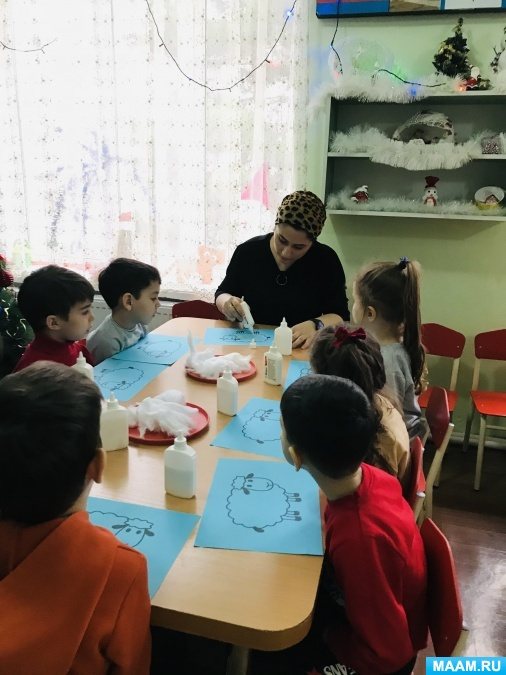
A group work was carried out on non-traditional drawing techniques. The goal was to introduce children to the elements of the cotton wool technique: tear small pieces from a large lump, crumple small pieces of cotton wool into lumps and glue them onto the silhouette of a sheep. Develop…
Methodical piggy bank
Thus, you see that the middle group of kindergarten offers the widest scope for choosing circle work. If parents wish, you can also offer a math group, or, for example, an English language group, organize a dance group, or show a puppet theater.
The main thing is that you are competent in the field of activity that you are applying for. Or clubs can be taught by other specialists, if there are any in the kindergarten, for example, dance or English.
To help you, there are teaching aids and recommendations for conducting classes that will help present the material in a beautiful and interesting form:
- “Artistic and aesthetic development of children 5-6 years old. Plasticineography classes";
- "Children's design. Plasticinography" and "Plastilinography 2";
- “Take care of the living. Game didactic material on ecology for children from 4 years old";
- “Theatrical activities in preschool educational institutions. Scenarios based on fairy tales of foreign writers and peoples of the world";
- “Artistic work in kindergarten. Middle group. Lesson notes and methodological recommendations."
And, tell us, dear teachers, what clubs are there in your kindergartens, which of them are the most popular? Parents can also take part in the survey and write what they would most like to do with their children in the garden. Maybe there are some new directions that I don’t know about yet. In general, share everything you know.
Don’t forget to like the article on social networks and subscribe to blog updates. We have a lot of interesting things ahead of us.
Sincerely, Tatyana Sukhikh! Till tomorrow!
By the way, I recommend reading:
Long-term planning of the work of the “Very Skillful Hands” circle in the middle group
Long-term planning of the work of the “Very Skillful Hands” circle in the middle group
Goal: to develop thinking, imagination, fine motor skills; cultivate independence, confidence, initiative.
Tasks:
1. To develop children’s interest in types of work.
2. Introduce the properties of materials.
3. Develop the ability to use simple tools.
4. Contribute to the development of skills in working with various materials.
5. Learn to paste ready-made forms, create images of finished objects from them, improving orientation on a plane.
6. Promote the development of constructive activities.
7. Develop hand steadiness and technical skills.
8. Promote the development of attention. Memory, imagination. Creative imagination.
SEPTEMBER.
1. "Apple". (Mosaic applique).
Goal: To teach how to glue small squares of colored paper into a circle, keeping the distance between them.
2. "Leaf". (Mosaic applique).
Goal: We continue to teach how to apply glue to a small area of the design and glue the squares, maintaining the distance, and so on until the entire leaf pattern is filled with squares.
3. "Carrot". (Thread applique).
Goal: To teach children to independently glue the finished shape onto a sheet of cardboard with the addition of yarn.
4. "Leaf fall." (Applique of dry leaves)
Goal: To teach how to stick dry leaves onto a sheet of paper, creating an image of leaf fall.
OCTOBER.
1. “Animals made from vegetables.” (Crafts from vegetables).
Goal: To teach children to do the work independently, to invite them to invent and make animals themselves, using toothpicks to connect.
2. "Trees". (Break applique).
Goal: To teach how to construct an image of the crown of a deciduous tree from scraps of green paper; tear off the edges of the paper in a rounded shape, depicting leaves. (teamwork) .
3. "Apple Orchard". (Applique made from napkins).
Purpose: Continue to introduce the properties of soft paper; teach how to roll large and small lumps (apples) out of it; develop imagination. (teamwork) .
4. “There are a lot of berries and flowers in the garden.” (Applique made from napkins).
Goal: To teach how to construct a landscape composition, to supplement the work begun with new elements; teach how to crumple soft paper into small lumps - berries, flowers. (teamwork) .
NOVEMBER.
1. “Animals”. (Craft made from natural materials).
Goal: To teach children to make animals from natural materials: the body is a cone, the head is a chestnut. Use plasticine to connect parts.
2. "Autumn Garden". (Leaf applique).
Goal: To teach how to make a composition from leaves. Carefully spread with glue and glue to the base.
3. “Pattern on the plate.” (Applique from pumpkin seeds).
Goal: To teach children to stick pumpkin seeds onto the finished image. Develop aesthetic perception. See beauty.
4. "Hedgehog". (Craft made from natural materials).
Goal: To teach children how to make a hedgehog from chestnut, to show their imagination, and to fashion small parts from plasticine.
DECEMBER.
1. “Cup and saucer.” (Papier-mâché craft).
Goal: To introduce children to a new type of manual labor. Learn to tear paper and strips and glue them in layers, alternating vertical and horizontal placement; coat with primer. Develop fine motor skills.
2. “Cup and saucer.” (Painting of the finished product).
Goal: Continuation. Learn how to decorate finished products with painting or appliqué. Develop your imagination and achieve the desired result.
3. “Stars and balls.” (Salt dough modeling).
Goal: Continue to introduce children to new material - salt dough. Learn how to stencil stars and balls for a Christmas tree using salt dough.
4. “Stars and balls.” (Painting the finished product).
Goal: Continuation. Learn to paint finished dough products with gouache, at the child’s request; coat with varnish and hang on the Christmas tree. Develop creativity and imagination.
JANUARY.
1. "Bunny". (Applique made of cotton wool).
Goal: To teach how to draw the silhouette of a cotton wool bunny on velvet paper, complementing the landscape with details made from colored paper.
2. “Magic snowflakes.” (Salt dough modeling).
Goal: To teach children how to make a snowflake from four thin sausages intersecting in the center. Develop your imagination in decorating snowflakes with beads.
3. "The Fox and the Wolf." (Construction - origami).
Goal: To introduce children to a new type of manual labor. Teach how to carefully fold a sheet of paper diagonally, lengthwise and crosswise. Listen carefully to the teacher’s explanations and repeat his actions.
FEBRUARY.
1. "Bullfinch". (Applique from cereals).
Goal: To teach how to evenly distribute various types of cereals in a mold smeared with plasticine, to develop accuracy and precision.
2. “Valentines”. (Applique from cut threads).
Goal: Continue to introduce the technique of making thread appliqués. Learn to evenly smear areas of the image and sprinkle them with finely chopped threads by the teacher.
3. “Our Army! "(Crafts from eggs).
Goal: To teach children to carefully glue ready-made molds onto an egg; eyes, mouth, headdress and vest for a sailor. Develop imagination and eye.
4. “Postcard for Defender of the Fatherland Day.” (Macaroni applique).
Goal: To teach children to decorate a postcard with pasta, creating an airplane, a rocket, a boat at the request of the children. Carefully glue it onto the cardboard.
MARCH.
1. "Photo frame." (Beading).
Goal: To teach children to decorate the shape of a frame with beads and decorative flowers. Distribute the glitter evenly on the front side.
2. “Animals from a strip of cardboard.” (Construction).
Goal: To teach children to cut narrow strips from a sheet of cardboard and glue these strips into rings. Model the animal yourself at your own discretion.
3. “First flowers.” (Applique made of colored paper).
Goal: To teach children to independently cut petals from a rectangle of colored paper and make a flower out of them.
4. “Exotic fish.” (Applique from pumpkin seeds).
Goal: To teach how to carefully glue pumpkin seeds onto applique elements, arranging them in a certain order.
APRIL.
1. "Chicken". (Applique from cereals).
Goal: Continue teaching children to glue cereal onto a finished silhouette. We sprinkle millet on the chicken, make a worm from buckwheat, and make grass from peas.
2. “Rockets and comets.” (Applique made of colored and corrugated paper).
Goal: To teach children to create and cut rockets in a rational way: divide the square into 3 triangles (a large triangle is the nose of the rocket, two small ones are the wings).
3. “Easter eggs. (Craft from a whole egg).
Goal: Continue to introduce children to new material - salt dough. Learn to roll the dough between your palms, giving it an egg shape. Decorate the form at the request of the child, using beads, colored paper or gouache when decorating.
4. “Elegant wings.” (Crafts from candy wrappers, corrugated paper).
Goal: Prepare different finger-sized cylinders. Learn how to make various insects whose body resembles a tube. Cut out the wings from candy wrappers and corrugated paper.
MAY.
1. “Beautiful dress.” (Fabric applique).
Goal: To teach how to make appliqué from fabric and correctly position decoration elements. Develop creative imagination.
2. “Decorative patterns on a circle.” (Craft from pumpkin seeds, watermelon and sunflower seeds).
Goal: To teach how to think about the content of a drawing on a circle and bring it to the end. Reinforce sculpting techniques. Develop imagination and creativity.
3. “Funny buttons.” (Salt dough modeling).
Goal: Learn to sculpt original buttons for a dress or blouse. Then we paint the buttons with bright gouache. Then air dry. 4. “Bouquet of roses.” (Corrugated paper applique).
Goal: To teach children to twist paper into flagella in a spiral; strengthen gluing skills, eye.


